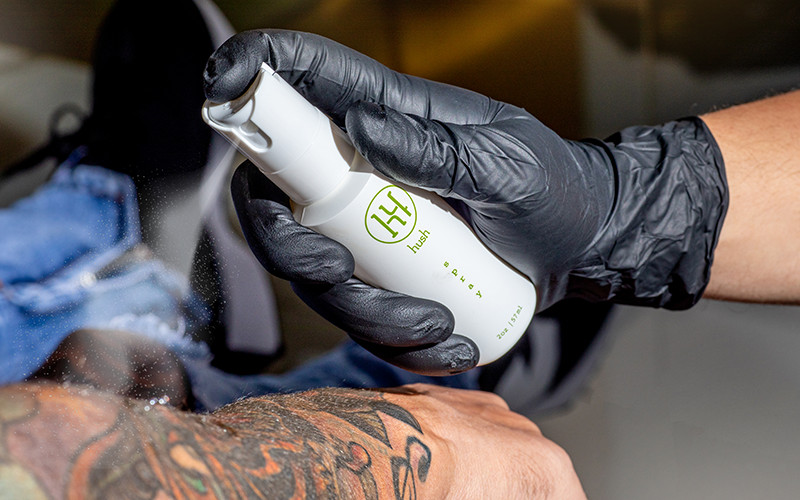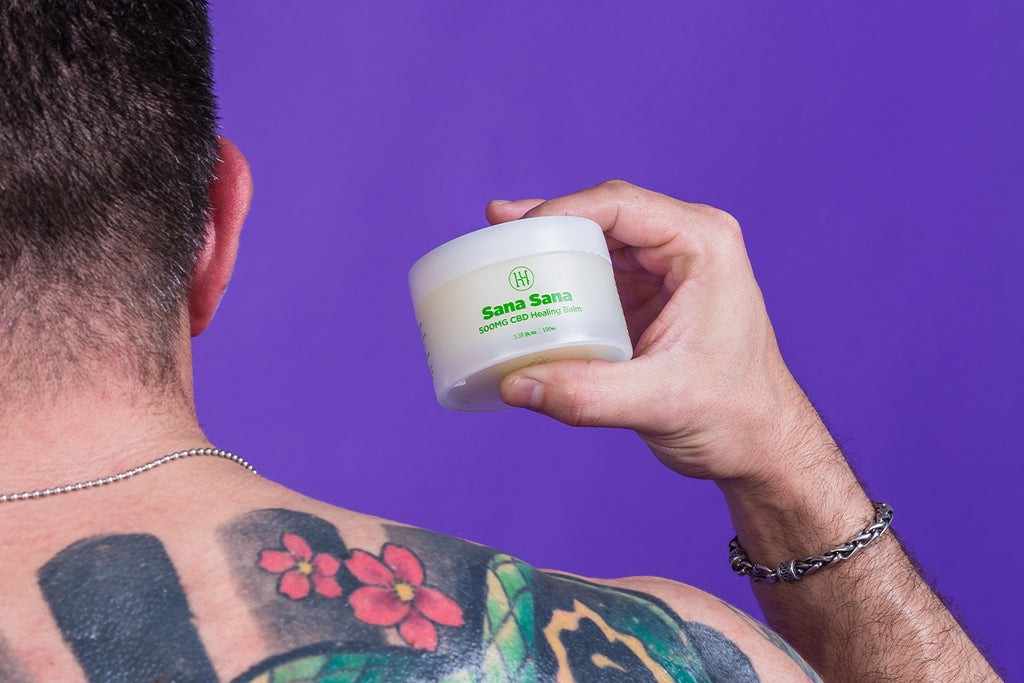Can you peel a tattoo scab? No, you should never peel a tattoo scab; doing so can disrupt the healing process and potentially damage your artwork. At tattooat.com, we understand the importance of proper tattoo aftercare and want to ensure your tattoo heals beautifully. Follow our guidance to avoid tattoo damage and encourage healthy skin regeneration.
1. What is Tattoo Peeling and Scabbing?
Tattoo peeling and scabbing are normal stages of the tattoo healing process. Think of it as your skin’s natural way of repairing itself after the tattooing process.
The Healing Process Explained
When you get a tattoo, the tattoo needle punctures the skin, injecting ink into the dermis layer. This creates a controlled wound that your body immediately begins to heal. The outer layer of skin, the epidermis, is damaged, which leads to peeling. Simultaneously, the body produces scabs to protect the wound from infection. According to research from Portland State University’s Art Department, in July 2025, proper aftercare significantly reduces healing time and minimizes complications.
Why Does Peeling Occur?
Peeling occurs as your body sheds the damaged cells from the epidermis. This is much like what happens after a sunburn. The old skin makes way for new, healthy skin to regenerate. The tattoo ink sits in the dermis layer, so the peeling itself doesn’t directly affect the tattoo’s appearance, but prematurely removing peeling skin can.
Why Do Scabs Form?
Scabs form as a protective barrier over the wounded area. They consist of dried blood, plasma, and other bodily fluids. Scabs prevent bacteria from entering the wound and causing infection. They also protect the underlying tissue as it repairs itself.
 Tattoo Peeling
Tattoo Peeling
2. Why is it Important Not to Peel Tattoo Scabs?
It is important not to peel tattoo scabs because doing so can lead to several complications that affect both the appearance and health of your tattoo.
Risk of Ink Loss
Peeling scabs prematurely can pull out the ink before the skin has fully healed. This results in patchy areas and fading in the tattoo design. The ink needs time to settle and become encapsulated by the skin cells in the dermis.
Increased Risk of Infection
Scabs act as a barrier against bacteria. Removing them exposes the open wound to potential infection. According to the Cleveland Clinic, tattoo infections can lead to serious health issues and require medical treatment.
Scarring
Picking at scabs disrupts the skin’s natural healing process, leading to the formation of scar tissue. Scars can distort the tattoo’s appearance and create raised or uneven skin texture.
Delayed Healing
When you peel a scab, you’re essentially reopening the wound. This forces your body to restart the healing process, prolonging the overall healing time and increasing the risk of complications.
3. How to Tell the Difference Between Normal and Abnormal Peeling or Scabbing?
Distinguishing between normal and abnormal peeling or scabbing is critical for proper tattoo aftercare. Normal peeling is usually mild and indicates that the tattoo is healing correctly, while abnormal peeling may signal a problem such as an infection.
Normal Tattoo Peeling
Normal peeling typically begins within the first week after getting the tattoo and lasts for about a week or two. The skin flakes off in small, thin pieces, similar to what happens after a sunburn. You might notice some color in the flakes, which is just the excess ink being shed from the top layer of skin.
Normal Tattoo Scabbing
Normal scabbing is thin and not overly thick. The scabs should be the same color as dried blood and should not be accompanied by excessive redness or swelling. According to Inked Magazine, light scabbing is a sign that the skin is protecting itself and healing correctly.
Abnormal Tattoo Peeling or Scabbing
Abnormal peeling involves intense redness, swelling, and a burning sensation. This could indicate an infection or allergic reaction. Abnormal scabbing includes thick, raised scabs that are difficult to remove and are often accompanied by pus or oozing.
Signs of Infection
- Increased pain and tenderness
- Excessive redness and swelling
- Pus or oozing from the tattoo
- Fever or chills
- Red streaks radiating from the tattoo area
If you experience any of these symptoms, consult a doctor or your tattoo artist immediately.
4. What Happens if You Accidentally Peel a Tattoo Scab?
Accidentally peeling a tattoo scab can be concerning, but it’s essential to handle it correctly to minimize potential damage.
Assess the Damage
First, evaluate the area where the scab was removed. Look for signs of bleeding, open skin, or ink loss. If the area looks relatively clean and there is minimal damage, proceed with gentle aftercare.
Gently Clean the Area
Wash the area with mild, fragrance-free soap and warm water. Use your fingertips to gently cleanse the area, removing any debris or blood. Pat the area dry with a clean paper towel.
Apply Aftercare Ointment
Apply a thin layer of aftercare ointment, such as Aquaphor or a specialized tattoo balm. This will help keep the area moisturized and protected from infection. Avoid using too much ointment, as this can trap moisture and promote bacterial growth.
Monitor for Signs of Infection
Keep a close eye on the area for any signs of infection, such as increased redness, swelling, or pus. If you notice any of these symptoms, seek medical attention immediately.
5. How to Properly Care for a Peeling or Scabbing Tattoo?
Proper tattoo aftercare is crucial for ensuring your tattoo heals correctly and maintains its vibrancy. Here are the key steps to follow:
Keep the Tattoo Clean
Gently wash your tattoo twice a day with mild, fragrance-free soap and warm water. Avoid using harsh soaps, exfoliants, or scented products, as these can irritate the skin and interfere with the healing process.
Moisturize Regularly
Apply a thin layer of aftercare ointment or lotion to your tattoo several times a day. This will help keep the skin hydrated and prevent excessive dryness and cracking. Look for products that are specifically designed for tattoo aftercare and contain ingredients like vitamin E, shea butter, or aloe vera. HUSH CBD Healing Balm is an excellent option.
 CBD Healing Balm
CBD Healing Balm
Avoid Sun Exposure
Protect your tattoo from direct sunlight by wearing loose-fitting clothing or applying a broad-spectrum sunscreen with an SPF of 30 or higher. Sun exposure can cause the ink to fade and damage the skin, prolonging the healing process.
Wear Loose Clothing
Wear loose-fitting clothing to avoid friction and irritation on the tattooed area. Tight clothing can rub against the skin, causing discomfort and potentially disrupting the scabs.
Stay Hydrated
Drinking plenty of water helps keep your skin hydrated from the inside out, promoting faster healing.
6. What to Avoid During the Tattoo Healing Process?
Knowing what to avoid during the tattoo healing process is just as important as knowing what to do. Here are some key things to avoid:
Avoid Soaking the Tattoo
Avoid soaking your tattoo in water for extended periods, such as swimming, taking baths, or using hot tubs. Prolonged exposure to water can cause the scabs to soften and fall off prematurely.
Avoid Scratching or Picking
Resist the urge to scratch or pick at your tattoo, even if it’s itchy. Scratching can damage the skin and disrupt the healing process, increasing the risk of infection and scarring.
Avoid Harsh Chemicals
Avoid using harsh chemicals, such as household cleaners, detergents, or strong perfumes, on or near your tattoo. These chemicals can irritate the skin and interfere with the healing process.
Avoid Shaving
Avoid shaving the tattooed area until it has fully healed. Shaving can irritate the skin and increase the risk of infection.
Avoid Excessive Exercise
Avoid excessive exercise or activities that cause excessive sweating. Sweat can create a breeding ground for bacteria, increasing the risk of infection.
7. How Long Does Tattoo Peeling and Healing Last?
The duration of tattoo peeling and healing varies from person to person, depending on factors such as the size and location of the tattoo, individual skin type, and adherence to aftercare instructions.
Typical Healing Timeline
- Week 1: Redness, swelling, and mild pain are common. The tattoo may start to ooze a clear or yellowish fluid.
- Week 2: Peeling and scabbing typically begin. The tattoo may be itchy.
- Week 3-4: The majority of peeling and scabbing should subside. The tattoo may appear slightly shiny or raised.
- Month 2-6: The tattoo should be fully healed. The skin should be smooth and the colors vibrant.
Factors Affecting Healing Time
- Size and Location of Tattoo: Larger tattoos and tattoos in areas with more friction (such as the hands or feet) tend to take longer to heal.
- Skin Type: Individuals with sensitive skin may experience a longer healing process.
- Aftercare: Proper aftercare, including keeping the tattoo clean and moisturized, can significantly speed up the healing process.
When to Seek Medical Attention
If you experience any signs of infection, such as increased pain, redness, swelling, pus, or fever, seek medical attention immediately.
8. Can Tattoo Numbing Products Affect Healing?
Tattoo numbing products can provide relief during the tattooing process, but it’s important to understand how they might affect healing.
Types of Numbing Products
- Topical Creams: Applied to the skin before the tattoo session.
- Sprays: Used during the tattoo session to reduce pain.
- Injected Anesthetics: Administered by a medical professional to numb a larger area.
Potential Effects on Healing
- Reduced Inflammation: Some numbing products contain anti-inflammatory ingredients that can help reduce swelling and redness.
- Delayed Healing: Overuse of numbing products can potentially interfere with the natural healing process by constricting blood vessels.
- Allergic Reactions: Some individuals may be allergic to the ingredients in numbing products, leading to skin irritation or infection.
Using Numbing Products Safely
- Consult with your tattoo artist before using any numbing products.
- Follow the instructions carefully and avoid overuse.
- Monitor for any signs of allergic reaction or skin irritation.
HUSH Numbing Spray can provide relief during the healing process by reducing discomfort without interfering with the body’s natural healing mechanisms.
9. Are There Any Home Remedies to Soothe a Peeling Tattoo?
While professional aftercare products are recommended, there are some home remedies that can help soothe a peeling tattoo.
Cold Compress
Applying a cold compress to the tattooed area can help reduce itching and inflammation. Wrap a bag of ice in a clean cloth and apply it to the tattoo for 10-15 minutes at a time.
Oatmeal Bath
Taking an oatmeal bath can help soothe irritated skin and relieve itching. Add one cup of colloidal oatmeal to a lukewarm bath and soak for 15-20 minutes.
Aloe Vera
Applying pure aloe vera gel to the tattoo can help moisturize the skin and reduce inflammation. Make sure to use a product that is free of additives and fragrances.
Coconut Oil
Coconut oil is a natural moisturizer that can help keep the skin hydrated and prevent dryness. Apply a thin layer of coconut oil to the tattoo several times a day.
Chamomile Tea Compress
Chamomile tea has anti-inflammatory properties that can help soothe irritated skin. Steep a chamomile tea bag in warm water, let it cool, and then apply the tea bag to the tattoo as a compress.
10. What Are Some Common Misconceptions About Tattoo Aftercare?
There are several misconceptions about tattoo aftercare that can lead to complications. Here are some common myths and the facts:
Myth: You Should Let Your Tattoo Dry Out
Fact: Keeping your tattoo moisturized is essential for proper healing. Dry skin can crack and become irritated, increasing the risk of infection.
Myth: You Should Use Antibacterial Ointment
Fact: Antibacterial ointments can be too harsh for tattoos and may interfere with the natural healing process. Use a specialized tattoo balm or a mild, fragrance-free lotion instead.
Myth: You Should Re-Bandage Your Tattoo
Fact: Re-bandaging your tattoo can trap moisture and bacteria, increasing the risk of infection. Once you remove the initial bandage, leave the tattoo exposed to air as much as possible.
Myth: Sunscreen is Only Necessary in the Summer
Fact: Sunscreen is essential year-round, even on cloudy days. UV rays can damage the skin and cause the ink to fade, regardless of the season.
Myth: All Tattoo Artists Give the Same Aftercare Advice
Fact: Aftercare advice can vary from artist to artist. Always follow the specific instructions provided by your tattoo artist.
Understanding the tattoo healing process and following proper aftercare instructions are essential for ensuring your tattoo looks its best for years to come. Remember to avoid peeling or picking at your tattoo and seek professional help if you have any concerns.
At tattooat.com, we are dedicated to providing you with the resources and support you need for a successful tattoo experience. Explore our extensive gallery of designs, connect with talented artists, and access expert advice on tattoo aftercare.
Address: 1825 SW Broadway, Portland, OR 97201, United States
Phone: +1 (503) 725-3000
Website: tattooat.com
FAQ About Tattoo Peeling
1. Why is my tattoo peeling so much?
Your tattoo is peeling because your body is shedding damaged skin cells from the epidermis layer, which is a normal part of the healing process.
2. Is it normal for a tattoo to peel after 3 days?
It’s less common, but possible. Peeling usually starts around the end of the first week, but individual healing times vary.
3. How long does tattoo peeling last?
Tattoo peeling typically lasts for about one to two weeks.
4. What happens if I peel a scab off my tattoo?
Peeling a scab can result in ink loss, scarring, and an increased risk of infection.
5. Can I use regular lotion on my peeling tattoo?
Use a mild, fragrance-free lotion specifically designed for tattoo aftercare.
6. How often should I moisturize my peeling tattoo?
Moisturize your tattoo several times a day to keep the skin hydrated and prevent excessive dryness.
7. What are the signs of an infected tattoo?
Signs of an infected tattoo include increased pain, redness, swelling, pus, and fever.
8. Can I go swimming with a peeling tattoo?
Avoid swimming with a peeling tattoo to prevent infection and disruption of the healing process.
9. How can I relieve itching during tattoo peeling?
Apply a cold compress or use a tattoo numbing spray to relieve itching.
10. When should I contact my tattoo artist or doctor about peeling?
Contact your tattoo artist or doctor if you notice signs of infection or have concerns about the healing process.
